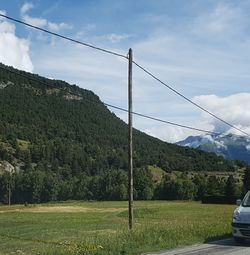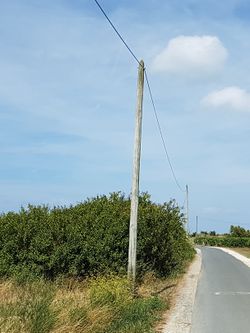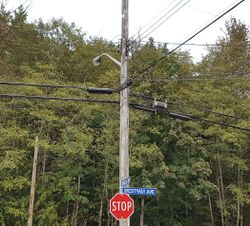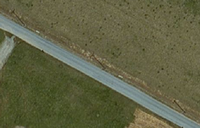Tag:man_made=utility_pole
| Description |
|---|
| A single pole supporting elevation of any of various and unspecified public utilities, such as power transmission, lighting or telephony. |
| Group: infrastructure |
| Used on these elements |
| Useful combination |
| Status: approved |
| Tools for this tag |
|
A single pole supporting elevation of any of various and unspecified public utilities, such as power transmission, lighting or telephony.
How to map
Place a node at the exact location of each pole. Add man_made=utility_pole, sometimes in replacement of communication=pole or telephone=pole. Also add corresponding main purpose with utility=*, often utility=telecom. Always use a single value for this key, see below.
| Key | Value | Comment | Recommendation |
|---|---|---|---|
| man_made | utility_pole | It's a pole supporting utility networks | mandatory (except for power poles) |
| utility | <main utility> | The purpose for which the pole was design or installed | recommended |
| material | <pole material> | The material composing the pole | recommended |
| height | <height> | Pole's height in meters as measured or read on ground | recommended |
| operator | <operator> | Name of the company that operates the pole | optional |
| manufacturer | <Manufacturing company> | Name of company that produced the pole | optional |
| ref | <reference> | Abbreviation / number of the pole as seen on ground. | optional |
| line_attachment | <line attachment> | Attachment mean for lines connected to that pole | optional |
| line_management | <line management> | Particular topology situations around the pole | optional |
| line_arrangement | <line arrangement> | Geometric configuration of line bundles supported by the pole | optional |
Find the appropriate utility
See appropriates values for utility=* to state to which activity the pole is mainly designed for.
A given pole is almost always operated by a single operator=*, not several. This given operator can make offers to support other utility lines without changing its own responsibility for maintenance or operations or the pole nature.
Answers to such questions are convenient to get the right value of utility=*:
- Who operates the pole? If the operator is a telecom operator, then utility=telecom and so on...
- If the operator operates several utilities and rolls out them at the same time, which one is most impacting pole structure? A power line is heavier than a telephone line for instance, then utility=power (and power=pole).
Logical link between poles and supported features
As utility=* is used with a single and the most representative value for each given pole, solutions should exist to link a single pole to numerous different activities and features.
Here is a list extracted from a topic of Talk page to link many activities to poles
- High voltage electricity: pole member of a power=line way
- Lower voltage electricity: pole member of a power=minor_line way
- Coaxial cable carrying TV; telephone & internet: pole member of a way with tags remaining to be defined (telecom=line eventually) + telecom:medium=coaxial
- Metal wire bundles for telephone & T1 internet (called POTS by telephone workers) : pole member of a way with tags remaining to be defined (telecom=line eventually) + telecom:medium=copper
- Fibre optic cables carrying TV; telephone & internet: pole member of a way with tags remaining to be defined (telecom=line eventually) + telecom:medium=fibre
- Electrical transformers: transformer=* on the pole (and eventually substation=*, see Proposed_features/Substation_nodes_extension)
- CATV or telephone equipment cabinets: street_cabinet=* on the pole
- Street lights highway=street_lamp on the pole
- A fire emergency pull box with a corresponding red light above : not aware of an eventual emergency=* value to add on the pole
- Wires used for local sound system used by local authorities, but that would be an additional way
- Surveillance camera/CCTV: Should find a way to let man_made=utility_pole and man_made=surveillance to coexists on the same feature. However surveillance isn't a proper utility.
As some of those points don't refer to any utility at all (but a street furniture, emergency response equipment and so on), there is no point to give the entire list of what is supported by a given pole with utility=*.
Examples
Power
| Photo | Location | Tagging | Note |
|---|---|---|---|
 |
France |
power=pole
|
The simplest power pole you'll find in France. There are around 11 millions of them to find. It's a wooden suspension pole holding a single minor low voltage power cable |
 |
Australia |
power=pole
|
A branching power pole in the corner of an Australia residential street |
Telecoms
| Photo | Locations | Tagging | Note |
|---|---|---|---|

|
France,
Ireland |
man_made=utility_pole
|
The simplest telecom pole you'll find in many European countries. In France, there are around 13 millions of them to find.
It's a wooden 7 m tall suspension pole holding a single telecom metal cable. A growing number of telecom providers are now adding fibre along the same paths. In Ireland, it is presumed that the vast majority of telecom poles are owned by OpenEir (a subsidiary of Eircom Limited). Very few are marked with the owner's name. |

|
Switzerland |
On foreground:
man_made=utility_pole
|
Such poles carry overhead and uninsulated telephone landlines. There are too numerous and thin wires for power distribution and transition shows a telecom connection box at the pole base.
It is still common in some countries and it illustrates accurately the need to describe the utility of all poles. |
Street lighting
| Photo | Location | Tagging | Note |
|---|---|---|---|
 |
Estonia |
highway=street_lamp
|
We can see an actual pole where a lamp is mounted on. It is an utility pole and its main purpose is street lighting. It differs from a lamp post and man_made=utility_pole can be used. |
Multi-utility
| Photo | Location | Tagging | Note |
|---|---|---|---|
 |
Canada |
power=pole
|
Let's focus on telecom lines only here despite it's a power pole holding a medium voltage line on top. The main line goes from left to right and is suspended on the pole while a branch line starts from its anchor. On this location, power and street lighting utilities are also installed and branch too. |
 |
Massachusetts, USA |
power=pole
|
A multi-utility pole beside a residential road in the USA. As it primarily holds low voltage power lines and then telephone cables, it remains a power=pole. Telecommunications lines have to be mapped with a dedicated way and a tag that remains to be defined. |
Possible mistakes
Some tagging values for telecom poles was used previously. You can replace it manually with caution.
| Photo | Location | Tagging | Note |
|---|---|---|---|
 |
UK | This is a lamp post and it's not an utility pole. There is no pole to describe and man_made=utility_pole shouldn't be used. |
See also
- A proposal to make this value reviewed
- WikiProject Telecoms § Telephone Poles
- French data model for utility networks (PCRS). Page 71, AffleurantPCRS base class definition which any utility pole inherits. Attribute reseau is equivalent to utility=* and is defined with a multiplicity of 0..1.
- proposed type=node relation can be used to map things attached to a pole

